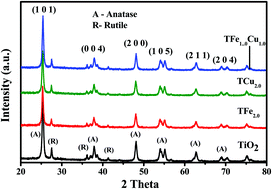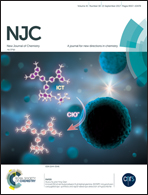Synthesis, characterization and anticancer activities of metal ions Fe and Cu doped and co-doped TiO2†
Abstract
TiO2 nanoparticles have been doped and co-doped with two metal ions (Fe and Cu) via the wet impregnation method. The doped and co-doped TiO2 have been characterized by standard analytical techniques like XRD, Raman spectra, FTIR, UV-Vis DRS, FESEM, and TEM. Powder XRD technique reveals that the modified catalyst majorly contains an anatase phase with the existence of metal ions in the lattice of TiO2. Raman and UV-Vis absorption spectra of the doped and co-doped catalyst show a λmax shift towards the longer wavelength region with an increase in metal ion concentration from 1 to 2%. FTIR patterns show the stretching and vibration patterns of the hydroxyl radicals present in the nanoparticles. FESEM images reveal that the average particle size of the modified TiO2 lies between 18 and 24 nm due to the asymmetric shape of nano crystallite TiO2. TEM images suggest that the doping and co-doping of metal ions do not leave any change in the shape of the nanoparticles. Furthermore, anti-cancerous activities of TiO2 nanoparticles and Fe, Cu doped and co-doped particles have been studied, revealing the toxicity of Cu ions doped TiO2 on cervical cancer cell line.



 Please wait while we load your content...
Please wait while we load your content...